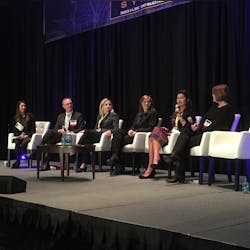With a large cultural divide between Baby Boomers and Millennials, it’s easy to see some challenges arise when it comes to accommodating their travel plans. However, plenty of similarities moving across the generational divide are giving transportation planners some idea of commonality to accommodate both sets of travelers.
Patty David, senior research advisor for AARP, said most Baby Boomers are traveling for leisure. According to the organization's 2016 Travel Trends Study, About half of them are traveling domestically and they’re visiting friends and family.
“I don’t think the reasons are different than anyone else as to why they travel,” David said.
How Boomers and Millennials travel was the focus of a March 3, panel discussion at the AAAE Airport Planning Design & Construction Symposium in Salt Lake City, where attendees learned what experts know on the travel patterns of these two major age groups.
David said boomer travel is seeing a shift in how the generation moves, with 30 percent going solo due to divorce, separation or the death of their partner. The group also sees a sizeable number of multigenerational travelers.
“They’re more likely to have children under 18 in the house as well as children over 18 that travel with them,” she said. “We have to pay attention and there’s a lot of the focus on the Millennials, but also the Boomers too. The Boomers are the Millennials parents and often they’re the ones paying for the Millennial trips.”
David said the boomers are focusing on luxury when they travel and stay loyal to rewards programs unless a bargain is too good to pass up to leave a program.
Katie Jones, director of business development for Sixtel Consulting Group, said the Millennials are more focused on the experience of their travels and are much more willing to scrimp on getting to their destination while paying more for experiences.
“We’re going to spend $1,000 on concert tickets to get to Coachella,” she said. “But we’re going to get there using Spirit and when we get there we’re going to camp.”
Jones said when it comes to the airports themselves, Millennials like accommodations like lounges and luxury items do matter.
“Maybe surprisingly this doesn’t mean maybe we only want self-serve kiosks and we put our earbuds in and we get on the plane and we don’t talk to anybody,” she said. “We’re looking for personalization, eye contact with our gate agents. I have the ability to check in on my kiosk and if there’s a line I’ll do it, but if I want to talk to somebody I need them to react to me and to make me feel valued to be on their flight and things like that.”
She added the younger travelers also want the airport experience to “not feel like every other box.”
“Because we’re more interested in the cultures I think this is a priority for us,” she said. “Looking when we land in Austin airport, it feels like Austin. And when you go to New Orleans you feel like you’re in New Orleans and you eat food that comes from New Orleans and these kinds of experiences make us feel like we're in this culture and we’re not a tourist having Cinnabon in Newark or something like that.”
David said Boomers are looking for a lot of the same items as well. Restaurants and shops are important to Boomers, but not so much the high end ones.
“They’re not necessarily using the wine bars or the chocolatiers or the spa services, but their children traveling with them are and they’ll pay for them to use them,” she said.
Sharon, McCloskey, vice president of marketing, Dallas/Fort Worth International Airport, said the facility is in the middle of a large capital investment plan and is going to replace all concessions over a period of years, meaning there will be more than 200 locations that will be more friendly to the millennials and other travelers.
“The Millennial population is growing…but we need to make the airport more comfortable for everyone,” she said. “Everyone is looking for the restaurants with the local flavor and more quality foodie aspects, but we also want to provide value options.”
Chris Birch, director of guest experience for San Francisco International Airport, said his facility strives for improvements as well, but one major area sticks out the most because Millennials will engage those extra facilities, but only after they’re ready.
“WiFi, WiFi, WiFi. And outlets,” he said. “I think we could probably tear the walls down, not put in windows and nobody would say a thing unless we didn’t have enough WiFi and enough outlets.”
McCloskey said DFW brought in AT&T to provide WiFi and pushed the fact it had to work at every gate. While it’s not perfect, it’s something they continue to strive at given how important travelers see it.
Airport staff also assessed the number of outlets per gate to meet the demands of all travelers. The issue is so important to travelers, she said the airport was even featured in Money Magazine for having the most outlets per gate.
“Most of our travelers have two mobile devices,” she said. “You don’t just need the outlets for the phone, you need it for the other mobile device whether it’s an iPad or what have you.”
About the Author
Joe Petrie
Editor & Chief
Joe Petrie is the Editorial Director for the Endeavor Aviation Group.
Joe has spent the past 20 years writing about the most cutting-edge topics related to transportation and policy in a variety of sectors with an emphasis on transportation issues for the past 15 years.
Contact: Joe Petrie
Editor & Chief | Airport Business
+1-920-568-8399
>> To download the AviationPros media kits, visit: Marketing Resource Center
>>Check out our aviation magazines: Ground Support Worldwide | Airport Business | Aircraft Maintenance Technology

